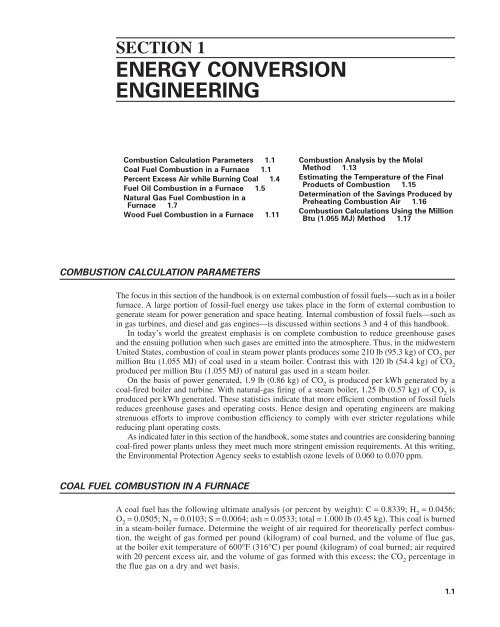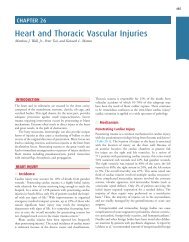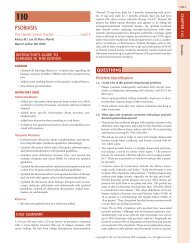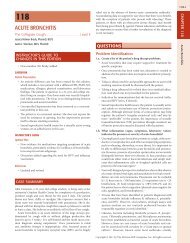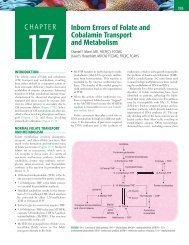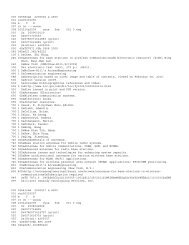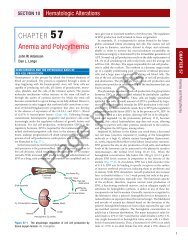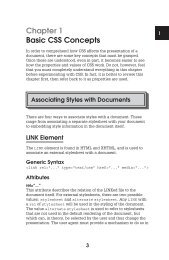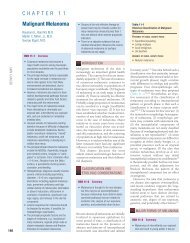section 1 energy conversion engineering
section 1 energy conversion engineering
section 1 energy conversion engineering
You also want an ePaper? Increase the reach of your titles
YUMPU automatically turns print PDFs into web optimized ePapers that Google loves.
SECTION 1<br />
ENERGY CONVERSION<br />
ENGINEERING<br />
Combustion Calculation Parameters 1.1<br />
Coal Fuel Combustion in a Furnace 1.1<br />
Percent Excess Air while Burning Coal 1.4<br />
Fuel Oil Combustion in a Furnace 1.5<br />
Natural Gas Fuel Combustion in a<br />
Furnace 1.7<br />
Wood Fuel Combustion in a Furnace 1.11<br />
Combustion CalCulation Parameters<br />
Combustion Analysis by the Molal<br />
Method 1.13<br />
Estimating the Temperature of the Final<br />
Products of Combustion 1.15<br />
Determination of the Savings Produced by<br />
Preheating Combustion Air 1.16<br />
Combustion Calculations Using the Million<br />
Btu (1.055 MJ) Method 1.17<br />
The focus in this <strong>section</strong> of the handbook is on external combustion of fossil fuels—such as in a boiler<br />
furnace. A large portion of fossil-fuel <strong>energy</strong> use takes place in the form of external combustion to<br />
generate steam for power generation and space heating. Internal combustion of fossil fuels—such as<br />
in gas turbines, and diesel and gas engines—is discussed within <strong>section</strong>s 3 and 4 of this handbook.<br />
In today’s world the greatest emphasis is on complete combustion to reduce greenhouse gases<br />
and the ensuing pollution when such gases are emitted into the atmosphere. Thus, in the midwestern<br />
United States, combustion of coal in steam power plants produces some 210 lb (95.3 kg) of CO 2 per<br />
million Btu (1.055 MJ) of coal used in a steam boiler. Contrast this with 120 lb (54.4 kg) of CO 2<br />
produced per million Btu (1.055 MJ) of natural gas used in a steam boiler.<br />
On the basis of power generated, 1.9 lb (0.86 kg) of CO 2 is produced per kWh generated by a<br />
coal-fired boiler and turbine. With natural-gas firing of a steam boiler, 1.25 lb (0.57 kg) of CO 2 is<br />
produced per kWh generated. These statistics indicate that more efficient combustion of fossil fuels<br />
reduces greenhouse gases and operating costs. Hence design and operating engineers are making<br />
strenuous efforts to improve combustion efficiency to comply with ever stricter regulations while<br />
reducing plant operating costs.<br />
As indicated later in this <strong>section</strong> of the handbook, some states and countries are considering banning<br />
coal-fired power plants unless they meet much more stringent emission requirements. At this writing,<br />
the Environmental Protection Agency seeks to establish ozone levels of 0.060 to 0.070 ppm.<br />
Coal Fuel Combustion in a FurnaCe<br />
A coal fuel has the following ultimate analysis (or percent by weight): C = 0.8339; H 2 = 0.0456;<br />
O 2 = 0.0505; N 2 = 0.0103; S = 0.0064; ash = 0.0533; total = 1.000 lb (0.45 kg). This coal is burned<br />
in a steam-boiler furnace. Determine the weight of air required for theoretically perfect combustion,<br />
the weight of gas formed per pound (kilogram) of coal burned, and the volume of flue gas,<br />
at the boiler exit temperature of 600°F (316°C) per pound (kilogram) of coal burned; air required<br />
with 20 percent excess air, and the volume of gas formed with this excess; the CO 2 percentage in<br />
the flue gas on a dry and wet basis.<br />
1.1
1.2 SECTION 1<br />
Calculation Procedure:<br />
1. Compute the weight of oxygen required per pound (kilogram) of coal<br />
To find the weight of oxygen required for theoretically perfect combustion of coal, set up the following<br />
tabulation, based on the ultimate analysis of the coal:<br />
Element ×<br />
C; 0.8339<br />
H 2 ; 0.0456<br />
O 2 ; 0.0505; decreases external O 2 required<br />
N 2 ; 0.0103 is inert in combustion and is<br />
ignored<br />
S; 0.0064<br />
Ash 0.0533 is inert in combustion and is<br />
ignored<br />
×<br />
×<br />
×<br />
Molecular-weight<br />
ratio =<br />
32 /12<br />
16 /2<br />
32 /32<br />
=<br />
=<br />
=<br />
=<br />
lb (kg) O 2<br />
required<br />
2.2237 (1.009)<br />
0.3648 (0.165)<br />
−0.0505 (0.023)<br />
0.0064 (0.003)<br />
Total 1.0000<br />
lb (kg) external O 2 per lb (kg) fuel = 2.5444 (1.154)<br />
Note that of the total oxygen needed for combustion, 0.0505 lb (0.023 kg), is furnished by the fuel<br />
itself and is assumed to reduce the total external oxygen required by the amount of oxygen present<br />
in the fuel. The molecular-weight ratio is obtained from the equation for the chemical reaction of<br />
the element with oxygen in combustion. Thus, for carbon C + O 2 → CO 2 , or 12 + 32 = 44, where 12<br />
and 32 are the molecular weights of C and O 2 , respectively.<br />
2. Compute the weight of air required for perfect combustion<br />
Air at sea level is a mechanical mixture of various gases, principally 23.2 percent oxygen and<br />
76.8 percent nitrogen by weight. The nitrogen associated with the 2.5444 lb (1.154 kg) of oxygen<br />
required per pound (kilogram) of coal burned in this furnace is the product of the ratio of the nitrogen<br />
and oxygen weights in the air and 2.5444, or (2.5444)(0.768/0.232) = 8.4228 lb (3.820 kg).<br />
Then the weight of air required for perfect combustion of 1 lb (0.45 kg) of coal = sum of nitrogen<br />
and oxygen required = 8.4228 + 2.5444 = 10.9672 lb (4.975 kg) of air per pound (kilogram) of<br />
coal burned.<br />
3. Compute the weight of the products of combustion<br />
Find the products of combustion by addition:<br />
Products of combustion<br />
Fuel constituents + Oxygen → lb kg<br />
C; 0.8339 + 2.2237 → CO 2 = 3.0576 1.387<br />
H; 0.0465 + 0.3648 → H 2 O = 0.4104 0.186<br />
O 2 ; 0.0505; this is not a product combustion<br />
N 2 ; 0.0103; inert but passes through furnace = 0.0103 0.005<br />
S; 0.0064 + 0.0064 → SO 2 = 0.0128 0.006<br />
Outside nitrogen from step 2 = N 2 = 8.4228 3.820<br />
lb (kg) of flue gas lb (kg) of coal burned = 11.9139 5.404<br />
4. Convert the flue-gas weight to volume<br />
Use Avogadro’s law, which states that under the same conditions of pressure and temperature, 1 mol<br />
(the molecular weight of a gas expressed in lb) of any gas will occupy the same volume.
ENERGY CONVERSION ENGINEERING 1.3<br />
At 14.7 lb/in 2 (abs) (101.3 kPa) and 32°F (0°C), 1 mol of any gas occupies 359 ft 3 (10.2 m 3 ).<br />
The volume per pound (kilogram) of any gas at these conditions can be found by dividing 359<br />
by the molecular weight of the gas and correcting for the gas temperature by multiplying the<br />
volume by the ratio of the absolute flue-gas temperature and the atmospheric temperature. To<br />
change the weight analysis (step 3) of the products of combustion to volumetric analysis, set up<br />
the calculation thus:<br />
Weight<br />
Molecular<br />
Volume at<br />
Products lb kg weight Temperature correction 600°F, ft3 316°C, m3 CO 2 3.0576 1.3869 44 (359/44)(3.0576)(2.15) = 53.6 1.518<br />
H 2 O 0.4104 0.1862 18 (359/18)(0.4104)(2.15) = 17.6 0.498<br />
Total N 2 8.4331 3.8252 28 (359/28)(8.4331)(2.15) = 232.5 6.584<br />
SO 4 0.0128 0.0058 64 (359/64)(0.0128)(2.15) = 0.15 0.004<br />
ft 3 (m 3 ) of flue gas per lb (kg) of coal burned = 303.85 8.604<br />
In this calculation, the temperature correction factor 2.15 = absolute flue-gas temperature, °R/absolute<br />
atmospheric temperature, °R = (600 + 460)/(32 + 460). The total weight of N 2 in the flue gas is<br />
the sum of the N 2 in the combustion air and the fuel, or 8.4228 + 0.0103 = 8.4331 lb (3.8252 kg).<br />
The value is used in computing the flue-gas volume.<br />
5. Compute the CO 2 content of the flue gas<br />
The volume of CO 2 in the products of combustion at 600°F (316°C) is 53.6 ft 3 (1.158 m 3 ), as computed<br />
in step 4, and the total volume of the combustion products is 303.85 ft 3 (8.604 m 3 ). Therefore,<br />
the percent CO 2 on a wet basis (i.e., including the moisture in the combustion products) = ft 3 CO 2 /<br />
total ft 3 = 53.6 / 303.85 = 0.1764, or 17.64 percent.<br />
The percent CO 2 on a dry, or Orsat, basis is found in the same manner, except that the weight of<br />
H 2 O in the products of combustion, 17.6 lb (7.83 kg) from step 4, is subtracted from the total gas<br />
weight. Or, percent CO 2 , dry, or Orsat basis = (53.6)/(303.85 − 17.6) = 0.1872, or 18.72 percent.<br />
6. Compute the air required with the stated excess flow<br />
With 20 percent excess air, the air flow required = (0.20 + 1.00)(air flow with no excess) = 1.20<br />
(10.9672) = 13.1606 lb (5.970 kg) of air per pound (kilogram) of coal burned. The air flow with no<br />
excess is obtained from step 2.<br />
7. Compute the weight of the products of combustion<br />
The excess air passes through the furnace without taking part in the combustion and increases the<br />
weight of the products of combustion per pound (kilogram) of coal burned. Therefore, the weight of<br />
the products of combustion is the sum of the weight of the combustion products without the excess<br />
air and the product of (percent excess air)(air for perfect combustion, lb); or, given the weights from<br />
steps 3 and 2, respectively, = 11.9139 + (0.20)(10.9672) = 14.1073 lb (6.399 kg) of gas per pound<br />
(kilogram) of coal burned with 20 percent excess air.<br />
8. Compute the volume of the combustion products and the percent CO 2<br />
The volume of the excess air in the products of combustion is obtained by converting from the weight<br />
analysis to the volumetric analysis and correcting for temperature as in step 4, using the air weight<br />
from step 2 for perfect combustion and the excess-air percentage, or (10.9672)(0.20)(359/28.95)<br />
(2.15) = 58.5 ft 3 (1.656 m 3 ). In this calculation the value 28.95 is the molecular weight of air. The<br />
total volume of the products of combustion is the sum of the column for perfect combustion, step 4,<br />
and the excess-air volume, above, or 303.85 + 58.5 = 362.35 ft 3 (10.261 m 3 ).<br />
By using the procedure in step 5, the percent CO 2 , wet basis = 53.6/362.35 = 14.8 percent. The<br />
percent CO 2 , dry basis = 53.8/(362.35 − 17.6) = 15.6 percent.<br />
Related Calculations. Use the method given here when making combustion calculations for any<br />
type of coal—bituminous, semibituminous, lignite, anthracite, cannel, or cooking—from any coal
1.4 SECTION 1<br />
field in the world used in any type of furnace—boiler, heater, process, or waste-heat. When the air<br />
used for combustion contains moisture, as is usually true, this moisture is added to the combustionformed<br />
moisture appearing in the products of combustion. Thus, for 80°F (26.7°C) air of 60 percent<br />
relative humidity, the moisture content is 0.013 lb/lb (0.006 kg/kg) of dry air. This amount appears<br />
in the products of combustion for each pound of air used and is a commonly assumed standard in<br />
combustion calculations.<br />
Fossil-fuel-fired power plants release sulfur emissions to the atmosphere. In turn, this produces<br />
sulfates, which are the key ingredient in acid rain. The federal Clean Air Act regulates sulfur dioxide<br />
emissions from power plants. Electric utilities which burn high-sulfur coal are thought to produce<br />
some 35 percent of atmospheric emissions of sulfur dioxide in the United States.<br />
Sulfur dioxide emissions by power plants have declined some 30 percent since passage of the<br />
Clean Air Act in 1970, and a notable decline in acid rain has been noted at a number of test sites.<br />
In 1990 the Acid Rain Control Program was created by amendments to the Clean Air Act. This<br />
program further reduces the allowable sulfur dioxide emissions from power plants, steel mills, and<br />
other industrial facilities.<br />
The same act requires reduction in nitrogen oxide emissions from power plants and industrial<br />
facilities, so designers must keep this requirement in mind when designing new and replacement<br />
facilities of all types which use fossil fuels.<br />
At the time of this writing, there are a number of states and countries considering phasing out<br />
coal-burning power plants at the end of their useful commercial lives if they do not install means to<br />
capture carbon dioxide and other greenhouse gases. These entities are also urging a shift to naturalgas<br />
fuel. Further, combined-cycle natural-gas-fueled power plants are being urged as replacements<br />
of coal-fired power plants.<br />
PerCent eXCess air WHile burninG Coal<br />
Calculation Procedure:<br />
A certain coal has the following composition by weight percentages: carbon 75.09, nitrogen 1.56,<br />
ash 3.38, hydrogen 5.72, oxygen 13.82, sulfur 0.43. When burned in an actual furnace, measurements<br />
showed that there was 8.93 percent combustible in the ash pit refuse and the following Orsat<br />
analysis in percentages was obtained: carbon dioxide 14.2, oxygen 4.7, carbon monoxide 0.3. If<br />
it can be assumed that there was no combustible in the flue gas other that the carbon monoxide<br />
reported, calculate the percentage of excess air used.<br />
1. Compute the amount of theoretical air required per lb m (kg) of coal<br />
Theoretical air required per pound (kilogram) of coal, w ta = 11.5C′ + 34.5[H′ 2 − O′ 2 /8)] + 4.32S′,<br />
where C′, H′ 2 , O′ 2 , and S′ represent the percentages by weight, expressed as decimal fractions,<br />
of carbon, hydrogen, oxygen, and sulfur, respectively. Thus, w ta = 11.5(0.7509) + 34.5[0.0572 −<br />
(0.1382/8)] + 4.32(0.0043) = 10.03 lb (4.55 kg) of air per lb (kg) of coal. The ash and nitrogen are<br />
inert and do not burn.<br />
2. Compute the correction factor for combustible in the ash<br />
The correction factor for combustible in the ash, C 1 = (w t C f − w r C r )/(w f × 100), where the amount<br />
of fuel, w f = 1 lb (0.45 kg) of coal; percent by weight, expressed as a decimal fraction, of carbon<br />
in the coal, C f = 75.09; percent by weight of the ash and refuse in the coal, w r = 0.0338; percent<br />
by weight of combustible in the ash, C r = 8.93. Hence, C 1 = [(1 × 75.09) − (0.0338 × 8.93)]/<br />
(l × 100) = 0.748.<br />
3. Compute the amount of dry flue gas produced per lb (kg) of coal<br />
The lb (kg) of dry flue gas per lb (kg) of coal, w dg = C 1 (4CO 2 + O 2 + 704)/[3(CO 2 + CO)], where<br />
the Orsat analysis percentages are for carbon dioxide, CO 2 = 14.2; oxygen, O 2 = 4.7; carbon
ENERGY CONVERSION ENGINEERING 1.5<br />
monoxide, CO = 0.3. Hence, w dg = 0.748 × [(4 × 14.2) + 4.7 + 704)]/[3(14.2 + 0.3)] = 13.16 lb/lb<br />
(5.97 kg/kg).<br />
4. Compute the amount of dry air supplied per lb (kg) of coal<br />
The lb (kg) of dry air supplied per lb (kg) of coal, w da = w dg – C 1 + 8[H′ 2 − (O′ 2 / 8)] − (N′ 2 / N),<br />
where the percentage by weight of nitrogen in the fuel, N′ 2 = 1.56, and “atmospheric nitrogen”<br />
in the supply air, N 2 = 0.768; other values are as given or calculated. Then, w da = 13.16 − 0.748 +<br />
8[0.0572 − (0.1382 / 8)] − (0.0156 / 0.768) = 12.65 lb / lb (5.74 kg/kg).<br />
5. Compute the percent of excess air used<br />
Percent excess air = (w da − w ta ) / w ta = (12.65 − 10.03) / 10.03 = 0.261, or 26.1 percent.<br />
Related Calculations. The percentage by weight of nitrogen in “atmospheric air” in step 4 appears in<br />
Principles of Engineering Thermodynamics, 2nd edition, by Kiefer et al., John Wiley & Sons, Inc.<br />
Fuel oil Combustion in a FurnaCe<br />
Calculation Procedure:<br />
A fuel oil has the following ultimate analysis: C = 0.8543; H 2 = 0.1131; O 2 = 0.0270; N 2 = 0.0022;<br />
S = 0.0034; total = 1.0000. This fuel oil is burned in a steam-boiler furnace. Determine the weight<br />
of air required for theoretically perfect combustion, the weight of gas formed per pound (kilogram)<br />
of oil burned, and the volume of flue gas, at the boiler exit temperature of 600°F (316°C), per pound<br />
(kilogram) of oil burned; the air required with 20 percent excess air, and the volume of gas formed<br />
with this excess; the CO 2 percentage in the flue gas on a dry and wet basis.<br />
1. Compute the weight of oxygen required per pound (kilogram) of oil<br />
The same general steps as given in the previous calculation procedure will be followed. Consult that<br />
procedure for a complete explanation of each step.<br />
Using the molecular weight of each element, we find<br />
Element × Molecular-weight ratio = lb (kg) O 2 required<br />
C; 0.8543 × 32 / 12 = 2.2781 (1.025)<br />
H2 ; 0.1131<br />
O2 ; 0.0270; decreases external O2 required<br />
N2 ; 0.0022 is inert in combustion<br />
and is ignored<br />
× 16 /2 =<br />
=<br />
0.9048<br />
− 0.0270<br />
(0.407)<br />
(− 0.012)<br />
S; 0.0034 × 32 / 32 = 0.0034 (0.002)<br />
Total 1.0000<br />
lb (kg) external O 2 per lb (kg) fuel = 3.1593 (1.422)<br />
2. Compute the weight of air required for perfect combustion<br />
The weight of nitrogen associated with the required oxygen = (3.1593)(0.768 / 0.232) = 10.458 lb<br />
(4.706 kg). The weight of air required = 10.4583 + 3.1593 = 13.6176 lb / lb (6.128 kg/kg) of oil<br />
burned.
1.6 SECTION 1<br />
3. Compute the weight of the products of combustion<br />
As before,<br />
Fuel constituents + Oxygen = Products of combustion<br />
C; 0.8543 + 2.2781 = 3.1324 = CO 2<br />
H 2 ; 0.1131 + 0.9148 = 1.0179 = H 2 O<br />
O 2 ; 0.270; not a product of combustion<br />
N 2 ; 0.0022; inert but passes through furnace = 0.0022 = N 2<br />
S; 0.0034 + 0.0034 = 0.0068 = SO 2<br />
Outside N 2 from step 2 = 10.458 = N 2<br />
lb (kg) of flue gas per lb (kg) of oil burned = 14.6173 (6.578)<br />
4. Convert the flue-gas weight to volume<br />
As before,<br />
Weight<br />
Molecular<br />
Volume at<br />
Products lb kg weight Temperature correction 600°F, ft3 316°C, m3 CO 2 3.1324 1.4238 44 (359 / 44)(3.1324)(2.15) = 55.0 1.557<br />
H 2 O 1.0179 0.4626 18 (359 / 18)(1.0179)(2.15) = 43.5 1.231<br />
N 2 (total) 10.460 4.7545 28 (359 / 28)(10.460)(2.15) = 288.5 8.167<br />
SO 2 0.0068 0.0031 64 (359 / 64)(0.0068)(2.15) = 0.82 0.023<br />
ft 3 (m 3 ) of flue gas per lb (kg) of oil burned = 387.82 10.978<br />
In this calculation, the temperature correction factor 2.15 = absolute flue-gas temperature, °R/<br />
absolute atmospheric temperature, °R = (600 + 460)/(32 + 460). The total weight of N 2 in the flue<br />
gas is the sum of the N 2 in the combustion air and the fuel, or 10.4580 + 0.0022 = 10.4602 lb<br />
(4.707 kg).<br />
5. Compute the CO 2 content of the flue gas<br />
CO 2 , wet basis = 55.0/387.82 = 0.142, or 14.2 percent. CO 2 , dry basis = 55.0/(387.2 − 43.5) = 0.160,<br />
or 16.0 percent.<br />
6. Compute the air required with stated excess flow<br />
The pounds (kilograms) of air per pound (kilogram) of oil with 20 percent excess air = (1.20)<br />
(13.6176) = 16.3411 lb (7.353 kg) of air per pound (kilogram) of oil burned.<br />
7. Compute the weight of the products of combustion<br />
The weight of the products of combustion = product weight for perfect combustion, lb + (percent<br />
excess air)(air for perfect combustion, lb) = 14.6173 + (0.20)(13.6176) = 17.3408 lb (7.803 kilogram)<br />
of flue gas per pound (kilogram) of oil burned with 20 percent excess air.<br />
8. Compute the volume of the combustion products and the percent CO 2<br />
The volume of excess air in the products of combustion is found by converting from the weight to<br />
the volumetric analysis and correcting for temperature as in step 4, using the air weight from step 2<br />
for perfect combustion and the excess-air percentage, or (13.6176)(0.20)(359/28.95)(2.15) = 72.7 ft 3<br />
(2.058 m 3 ). Add this to the volume of the products of combustion found in step 4, or 387.82 + 72.70 =<br />
460.52 ft 3 (13.037 m 3 ).<br />
By using the procedure in step 5, the percent CO 2 , wet basis = 55.0/460.52 = 0.1192, or 11.92 percent.<br />
The percent CO 2 , dry basis = 55.0/(460.52 − 43.5) = 0.1318, or 13.18 percent.
ENERGY CONVERSION ENGINEERING 1.7<br />
Related Calculations. Use the method given here when making combustion calculations for any<br />
type of fuel oil—paraffin-base, asphalt-base, Bunker C, no. 2, 3, 4, or 5—from any source, domestic<br />
or foreign, in any type of furnace—boiler, heater, process, or waste-heat. When the air used for<br />
combustion contains moisture, as is usually true, this moisture is added to the combustion-formed<br />
moisture appearing in the products of combustion. Thus, for 80°F (26.7°C) air of 60 percent relative<br />
humidity, the moisture content is 0.013 lb/lb (0.006 kg/kg) of dry air. This amount appears in the<br />
products of combustion for each pound (kilogram) of air used and is a commonly assumed standard<br />
in combustion calculations.<br />
natural Gas Fuel Combustion in a FurnaCe<br />
Calculation Procedure:<br />
A natural gas has the following volumetric analysis at 60°F (15.5°C): CO 2 = 0.004; CH 4 = 0.921;<br />
C 2 H 6 = 0.041; N 2 = 0.034; total = 1.000. This natural gas is burned in a steam-boiler furnace.<br />
Determine the weight of air required for theoretically perfect combustion, the weight of gas formed<br />
per pound (kilogram) of natural gas burned, and the volume of the flue gas, at the boiler exit temperature<br />
of 650°F (343°C), per pound (kilogram) of natural gas burned; air required with 20 percent<br />
excess air, and the volume of gas formed with this excess: CO 2 percentage in the flue gas on a dry<br />
and wet basis.<br />
1. Compute the weight of oxygen required per pound of gas<br />
The same general steps as given in the previous calculation procedures will be followed, except that<br />
they will be altered to make allowances for the differences between natural gas and coal.<br />
The composition of the gas is given on a volumetric basis, which is the usual way of expressing a<br />
fuel-gas analysis. To use the volumetric-analysis data in combustion calculations, they must be converted<br />
to a weight basis. This is done by dividing the weight of each component by the total weight<br />
of the gas. A volume of 1 ft 3 (1 m 3 ) of the gas is used for this computation. Find the weight of each<br />
component and the total weight of 1 ft 3 (1 m 3 ) as follows, using the properties of the combustion<br />
elements and compounds given in Table 1:<br />
Density<br />
Component weight =<br />
column 1 × column 2<br />
Component Percent by volume lb/ft 3 kg/m 3 lb/ft 3 kg/m 3<br />
CO 2 0.004 0.1161 1.859 0.0004644 0.007<br />
CH 4 0.921 0.0423 0.677 0.0389583 0.624<br />
C 2 H 6 0.041 0.0792 1.268 0.0032472 0.052<br />
N 2 0.034 0.0739 0.094 0.0025026 0.040<br />
Total 1.000 0.0451725 0.723<br />
Percent CO 2 = 0.0004644/0.0451725 = 0.01026, or 1.03 percent<br />
Percent CH 4 by weight = 0.0389583/0.0451725 = 0.8625, or 86.25 percent<br />
Percent C 2 H 6 by weight = 0.0032472/0.0451725 = 0.0718, or 7.18 percent<br />
Percent N 2 by weight = 0.0025026/0.0451725 = 0.0554, or 5.54 percent<br />
The sum of the weight percentages = 1.03 + 86.25 + 7.18 + 5.54 = 100.00. This sum checks the<br />
accuracy of the weight calculation, because the sum of the weights of the component parts should<br />
equal 100 percent.
1.8<br />
TABLE 1 Properties of Combustion Elements*<br />
Heat value, Btu (kJ)<br />
Nature<br />
At 14.7 lb / in2 (abs) (101.3 kPa),<br />
60°F (15.6°C)<br />
Per ft3 (m3 ) at<br />
14.7 lb/in2 (abs)<br />
(101.3 kPa), 60°F<br />
(15.6°C) Per mole<br />
Per lb (kg)<br />
Gas or<br />
solid Combustible<br />
Volume, ft3 /lb<br />
(m3 /kg)<br />
Weight, lb/ft3 (kg/m3 )<br />
—<br />
0.0053 (0.0849)<br />
—<br />
0.0739 (1.183)<br />
0.0423 (0.677)<br />
0.0686 (1.098)<br />
0.0739 (1.183)<br />
0.0792 (1.268)<br />
0.0844 (1.351)<br />
0.0739 (1.183)<br />
0.0765 (1.225)<br />
0.1161 (1.859)<br />
0.0475 (0.760)<br />
Molecular<br />
weight<br />
Element or compound Formula<br />
174,500<br />
123,100<br />
129,600<br />
122,400<br />
384,000<br />
562,000<br />
622,400<br />
668,300<br />
—<br />
325 (12,109)<br />
—<br />
323 (12,035)<br />
1,012 (37,706)<br />
1,483 (55,255)<br />
1,641 (61,141)<br />
1,762 (65,650)<br />
14,540 (33,820)<br />
61,000 (141,886)<br />
4,050 (9,420)<br />
4,380 (10,187)<br />
24,000 (55,824)<br />
21,500 (50,009)<br />
22,200 (51,637)<br />
22,300 (51,870)<br />
Yes<br />
Yes<br />
Yes<br />
Yes<br />
Yes<br />
Yes<br />
Yes<br />
Yes<br />
S<br />
G<br />
S<br />
G<br />
G<br />
G<br />
G<br />
G<br />
G<br />
G<br />
G<br />
G<br />
G<br />
—<br />
188 (11.74)<br />
—<br />
13.54 (0.85)<br />
23.69 (1.48)<br />
14.58 (0.91)<br />
13.54 (0.85)<br />
12.63 (0.79)<br />
11.84 (0.74)<br />
13.52 (0.84)<br />
13.07 (0.82)<br />
8.61 (0.54)<br />
21.06 (1.31)<br />
12<br />
2.02 †<br />
32<br />
28<br />
16<br />
26<br />
28<br />
30<br />
32<br />
28<br />
29<br />
44<br />
18<br />
C<br />
H2 S<br />
CO<br />
CH4 C2H2 C2H4 C2H6 O2 N2 —<br />
CO2 H2O Carbon<br />
Hydrogen<br />
Sulfur<br />
Carbon monoxide<br />
Methane<br />
Acetylene<br />
Ethylene<br />
Ethane<br />
Oxygen<br />
Nitrogen<br />
Air ‡<br />
Carbon dioxide<br />
Water<br />
*P. W. Swain and L. N. Rowley, “Library of Practical Power Engineering” (collection of articles published in Power).<br />
† For most practical purposes, the value of 2 is sufficient.<br />
‡ The molecular weight of 29 is merely the weighted average of the molecular weight of the constituents.
TABLE 2 Chemical Reactions<br />
ENERGY CONVERSION ENGINEERING 1.9<br />
Next, find the oxygen required for combustion. Since both the CO 2 and N 2 are inert, they do not<br />
take part in the combustion; they pass through the furnace un changed. Using the molecular weights<br />
of the remaining components in the gas and the weight percentages, we have<br />
Compound × Molecular-weight ratio = lb (kg) O 2 required<br />
CH 4 ; 0.0718<br />
C 2 H 6 ; 0.0718<br />
lb (kg) external O 2 required<br />
per lb (kg) fuel<br />
×<br />
×<br />
64/16<br />
112/30<br />
=<br />
=<br />
=<br />
3.4500 (1.553)<br />
0.2920 (0.131)<br />
3.7420 (1.684)<br />
In this calculation, the molecular-weight ratio is obtained from the equation for the combustion<br />
chemical reaction, or CH 4 + 2O 2 = CO 2 + 2H 2 O, that is, 16 + 64 = 44 + 36, and C 2 H 6 + 7/2O 2 =<br />
2CO 2 + 3H 2 O 2 , that is 30 + 112 = 88 + 54. See Table 2 from these and other useful chemical<br />
reactions in combustion.<br />
Combustible substance Reaction Mols lb (kg)*<br />
Carbon to carbon monoxide C + ½O 2 = CO 1 + ½ = 1 12 + 16 = 28<br />
Carbon to carbon dioxide C + O 2 = CO 2 1 + 1 = 1 12 + 16 = 28<br />
Carbon monoxide to carbon dioxide CO + ½O 2 = CO 2 1 + ½ = 1 28 + 16 = 44<br />
Hydrogen H 2 + ½O 2 = H 2 O 1 + ½ = 1 2 + 16 = 18<br />
Sulfur to sulfur dioxide S + O 2 = SO 2 1 + 1 = 1 32 + 32 = 64<br />
Sulfur to sulfur trioxide S + 3/2O 2 = SO 3 1 + 2/2 = 1 32 + 48 = 80<br />
Methane CH 4 + 2O 2 = CO 2 + 2H 2 O 1 + 2 = 1 + 2 16 + 64 = 44 + 36<br />
Ethane C 2 H 6 + 7/2O 2 = 2CO 2 + 3H 2 O 1 + 7/2 = 2 + 3 30 + 112 = 88 + 54<br />
Propane C 3 H 8 + 5O 2 = 3CO 2 + 4H 2 O 1 + 5 = 3 + 4 44 + 160 = 132 + 72<br />
Butane C 4 H 10 + 13/2O 2 = 4CO 2 + 5H 2 O 1 + 12/2 = 4 + 5 58 + 208 = 176 + 90<br />
Acetylene C 2 H 2 + 5/2O 2 = 2CO 2 + H 2 O 1 + 5/2 = 2 + 2 26 + 80 = 88 + 18<br />
Ethylene C 2 H 4 + 3O 2 = 2CO 2 + 2H 2 O 1 + 3 = 2 + 2 28 + 96 = 88 + 36<br />
*Substitute the molecular weights in the reaction equation to secure lb (kg). The lb (kg) on each side of the equation must balance.<br />
2. Compute the weight of air required for perfect combustion<br />
The weight of nitrogen associated with the required oxygen = (3.742)(0.768/0.232) = 12.39 lb (5.576 kg).<br />
The weight of air required = 12.39 + 3.742 = 16.132 lb/lb (7.259 kg/kg) of gas burned.<br />
3. Compute the weight or the products of combustion<br />
Products of combustion<br />
Fuel constituents + Oxygen = lb kg<br />
CO2 ; 0.0103: inert but passes<br />
through the furnace<br />
= 0.010300 0.005<br />
CH4 ; 0.8625<br />
C2H6 ; 0.003247<br />
N2 ; 0.0554; inert but passes<br />
through the furnace<br />
+<br />
+<br />
3.45<br />
0.2920<br />
=<br />
=<br />
=<br />
4.312500<br />
0.032447<br />
0.055400<br />
1.941<br />
0.015<br />
0.025<br />
Outside N2 from step 2<br />
lb (kg) of flue gas per lb (kg) of<br />
natural gas burned<br />
=<br />
=<br />
12.390000<br />
16.800347<br />
5.576<br />
7.562
1.10 SECTION 1<br />
4. Convert the flue-gas weight to volume<br />
The products of complete combustion of any fuel that does not contain sulfur are CO 2 , H 2 O, and<br />
N 2 . Using the combustion equation in step 1, compute the products of combustion thus: CH 4 + 2O 2 =<br />
CO 2 + H 2 O; 16 + 64 = 44 + 36; or the CH 4 burns to CO 2 in the ratio of 1 part CH 4 to 44/16 parts CO 2 .<br />
Since, from step 1, there is 0.03896 lb CH 4 per ft 3 (0.624 kg/m 3 ) of natural gas, this forms (0.03896)<br />
(44/16) = 0.1069 lb (0.048 kg) of CO 2 . Likewise, for C 2 H 6 , (0.003247)(88/30) = 0.00952 lb (0.004<br />
kg). The total CO 2 in the combustion products = 0.00464 + 0.1069 + 0.00952 = 0.11688 lb (0.053<br />
kg), where the first quantity is the CO 2 in the fuel.<br />
Using a similar procedure for the H 2 O formed in the products of combustion by CH 4 , we find<br />
(0.03896)(36/16) = 0.0875 lb (0.039 kg). For C 2 H 6 , (0.003247)(54/30) = 0.005816 lb (0.003 kg). The<br />
total H 2 O in the combustion products = 0.0875 + 0.005816 = 0.093316 lb (0.042 kg).<br />
Step 2 shows that 12.39 lb (5.58 kg) of N 2 is required per lb (kg) of fuel. Since 1 ft 3 (0.028 m 3 ) of<br />
the fuel weights 0.04517 lb (0.02 kg), the volume of gas which weighs 1 lb (2.2 kg) is 1/0.04517 =<br />
22.1 ft 3 (0.626 m 3 ). Therefore, the weight of N 2 per ft 3 of fuel burned = 12.39/22.1 = 0.560 lb (0.252 kg).<br />
This, plus the weight of N 2 in the fuel, step 1, is 0.560 + 0.0025 = 0.5625 lb (0.253 kg) of N 2 in the<br />
products of combustion.<br />
Next, find the total weight of the products of combustion by taking the sum of the CO 2 , H 2 O, and<br />
N 2 weights, or 0.11688 + 0.09332 + 0.5625 = 0.7727 lb (0.35 kg). Now convert each weight to ft 3 at<br />
650°F (343°C), the temperature of the combustion products, or:<br />
Weight<br />
Molecular<br />
Volume at<br />
Products lb kg weight Temperature correction 650°F, ft3 343°C, m3 CO 2 0.11688 0.05302 44 (379/44)(0.11688)(2.255) = 2.265 0.0641<br />
H 2 O 0.09332 0.04233 18 (379/18)(0.09332)(2.255) = 4.425 0.1252<br />
N 2 (total) 0.5625 0.25515 28 (379/28)(0.5625)(2.255) = 17.190 0.4866<br />
ft 3 (m 3 ) of flue gas per ft 3 (m 3 ) of natural-gas fuel = 23.880 0.6759<br />
In this calculation, the value of 379 is used in the molecular-weight ratio because at 60°F (15.6°C)<br />
and 14.7 lb/in 2 (abs) (101.3 kPa), the volume of 1 lb (0.45 kg) of any gas = 379/gas molecular weight.<br />
The fuel gas used is initially at 60°F (15.6°C) and 14.7 lb/in 2 (abs) (101.3 kPa). The ratio 2.255 =<br />
(650 + 460)/(32 + 460).<br />
5. Compute the CO 2 content of the flue gas<br />
CO 2 , wet basis = 2.265/23.88 = 0.947, or 9.47 percent. CO 2 , dry basis = 2.265/(23.88 − 4.425) = 0.1164,<br />
or 11.64 percent.<br />
6. Compute the air required with the stated excess flow<br />
With 20 percent excess air, (1.20)(16.132) = 19.3584 lb of air per lb (8.71 kg/kg) of natural gas, or<br />
19.3584/22.1 = 0.875 lb of air per ft 3 (13.9 kg/m 3 ) of natural gas. See step 4 for an explanation of<br />
the value 22.1.<br />
7. Compute the weight of the products of combustion<br />
Weight of the products of combustion = product weight for perfect combustion, lb + (percent excess<br />
air) (air for perfect combustion, lb) = 16.80 + (0.20)(16.132) = 20.03 lb (9.01 kg).<br />
8. Compute the volume of the combustion products and the percent CO 2<br />
The volume of excess air in the products of combustion is found by converting from the weight to<br />
the volumetric analysis and correcting for temperature as in step 4, using the air weight from step 2 for<br />
perfect combustion and the excess-air percentage, or (16.132/22.l)(0.20)(379/28.95)(2.255) = 4.31 ft 3<br />
(0.122 m 3 ). Add this to the volume of the products of combustion found in step 4, or 23.88 + 4.31 =<br />
28.19 ft 3 (0.798 m 3 ).<br />
By the procedure in step 5, the percent CO 2 , wet basis = 2.265/28.19 = 0.0804, or 8.04 percent.<br />
The percent CO 2 , dry basis = 2.265/(28.19 − 4.425) = 0.0953, or 9.53 percent.
ENERGY CONVERSION ENGINEERING 1.11<br />
Related Calculations. Use the method given here when making combustion calculations for any<br />
type of gas used as a fuel—natural gas, blast-furnace gas, coke-oven gas, producer gas, water gas,<br />
sewer gas—from any source, domestic or for eign, in any type of furnace—boiler, heater, process, or<br />
waste-heat. When the air used for combustion contains moisture, as is usually true, this moisture is<br />
added to the combustion-formed moisture appearing in the products of combustion. Thus, for 80°F<br />
(26.7°C) air of 60 percent relative humidity, the moisture content is 0.013 lb/lb (0.006 kg/kg) of dry<br />
air. This amount appears in the products of combustion for each pound of air used and is a commonly<br />
assumed standard in combustion calculations.<br />
WooD Fuel Combustion in a FurnaCe<br />
Calculation Procedure:<br />
The weight analysis of a yellow-pine wood fuel is: C = 0.490; H 2 = 0.074; O 2 = 0.406; N 2 = 0.030.<br />
Determine the weight of oxygen and air required with perfect combustion and with 20 percent excess<br />
air. Find the weight and volume of the products of combustion under the same conditions, and the<br />
wet and dry CO 2 . The flue-gas temperature is 600°F (316°C). The air supplied for combustion has a<br />
mois ture content of 0.013 lb/lb (0.006 kg/kg) of dry air.<br />
1. Compute the weight of oxygen required per pound (kilogram) of wood<br />
The same general steps as given in earlier calculation procedures will be followed; consult them for<br />
a complete explanation of each step. Using the molecular weight of each element, we have<br />
Element × Molecular-weight ratio = lb (kg) O 2 required<br />
C; 0.490 × 32 /12 = 1.307 (0.588)<br />
H 2 ; 0.074 × 16 / 2 = 0.592 (0.266)<br />
O 2 ; 0.406; decreases external O 2 required = −0.406 (−0.183)<br />
N 2 ; 0.030 inert in combustion<br />
Total 1.000<br />
lb (kg) external O 2 per lb (kg) fuel = 1.493 (0.671)<br />
2. Compute the weight of air required for complete combustion<br />
The weight of nitrogen associated with the required oxygen = (1.493)(0.768 / 0.232) = 4.95 lb (2.228 kg).<br />
The weight of air required = 4.95 + 1.493 = 6.443 lb / lb (2.899 kg / kg) of wood burned, if the air is<br />
dry. But the air contains 0.013 lb of moisture per lb (0.006 kg / kg) of air. Hence, the total weight of<br />
the air = 6.443 + (0.013)(6.443) = 6.527 lb (2.937 kg).<br />
3. Compute the weight of the products of combustion<br />
Use the following relation:<br />
Fuel constituents + Oxygen = Products of combustion, lb (kg)<br />
C; 0.490 + 1.307 = 1.797 (0.809) = CO 2<br />
H 2 ; 0.074 + 0.592 = 0.666 (0.300) = H 2 O<br />
O 2 ; not a product of combustion<br />
N 2 ; inert but passes through the furnace = 0.030 (0.014) = N 2<br />
Outside N 2 from step 2 = 4.950 (2.228) = N 2<br />
Outside moisture from step 2 = 0.237 (0.107)<br />
lb (kg) of flue gas per lb (kg) of wood burned = 7.680 (3.458)
1.12 SECTION 1<br />
4. Convert the flue-gas weight to volume<br />
Use, as before, the following tabulation:<br />
Weight<br />
Molecular<br />
Volume at<br />
Products lb kg weight Temperature correction 600°F, ft3 316°C, m3 CO 2 1.797 0.809 44 (359/44)(1.797)(2.15) = 31.5 0.892<br />
H 2 O (fuel) 0.666 0.300 18 (359/18)(0.666)(2.15) = 28.6 0.810<br />
N 2 (total) 4.980 2.241 28 (359/28)(4.980)(2.15) = 137.2 3.884<br />
H 2 O (outside air) 0.837 0.377 18 (359/18)(0.837)(2.15) = 35.9 10.16<br />
Cu ft (m 3 ) of flue gas per lb (kg) of oil 233.2 6.602<br />
In this calculation the temperature correction factor 2.15 = (absolute flue-gas tem perature, °R)/<br />
(absolute atmospheric temperature, °R) = (600 + 460)/(32 + 460). The total weight of N 2 is the sum<br />
of the N 2 in the combustion air and the fuel.<br />
5. Compute the CO 2 content of the flue gas<br />
The CO 2 , wet basis = 31.5/233.2 = 0.135, or 13.5 percent. The CO 2 , dry basis = 31.5/(233.2 − 28.6 −<br />
35.9) = 0.187, or 18.7 percent.<br />
6. Compute the air required with the stated excess flow<br />
With 20 percent excess air, (1.20)(6.527) = 7.832 lb (3.524 kg) of air per lb (kg) of wood burned.<br />
7. Compute the weight of the products of combustion<br />
The weight of the products of combustion = product weight for perfect combustion, lb + (percent<br />
excess air)(air for perfect combustion, lb) = 8.280 + (0.20)(6.527) = 9.585 lb (4.313 kg) of flue gas<br />
per lb (kg) of wood burned with 20 percent excess air.<br />
8. Compute the volume of the combustion products and the percent CO 2<br />
The volume of the excess air in the products of combustion is found by converting from the weight<br />
to the volumetric analysis and correcting for temperature as in step 4, using the air weight from step 2<br />
for perfect combustion and the excess-air per centage, or (6.527)(0.20)(359/28.95)(2.15) = 34.8 ft 3<br />
(0.985 m 3 ). Add this to the volume of the products of combustion found in step 4, or 233.2 + 34.8 =<br />
268.0 ft 3 (7.587 m 3 ).<br />
By using the procedure in step 5, the percent CO 2 , wet basis = 31.5/268 = 0.1174, or 11.74 percent.<br />
The percent CO 2 , dry basis = 31.5/(268 − 28.6 − 35.9 − 0.20 × 0.837) = 0.155, or 15.5 percent. In<br />
the dry-basis calculation, the factor (0.20)(0.837) is the outside moisture in the excess air.<br />
Related Calculations. Use the method given here when making combustion calculations for any<br />
type of wood or woodlike fuel—spruce, cypress, maple, oak, sawdust, wood shavings, tanbark,<br />
bagesse, peat, charcoal, redwood, hemlock, fir, ash, birch, cottonwood, elm, hickory, walnut,<br />
chopped trimmings, hogged fuel, straw, corn, cottonseed hulls, city refuse—in any type of furnace—<br />
boiler, heating, process, or waste-heat. Most of these fuels contain a small amount of ash—usually<br />
less than 1 percent. This was ignored in this calculation procedure because it does not take part in<br />
the combustion.<br />
Industry is making greater use of discarded process waste to generate electricity and steam by<br />
burning the waste in a steam boiler. An excellent example is that of Agrilectric Power Partners Ltd.,<br />
Lake Charles, LA. This plant burns rice hulls from its own process and buys other producers’ surplus<br />
rice hulls for continuous opera tion. Their plant is reported as the first small-power-production facility<br />
to operate on rice hulls.<br />
By burning the waste rice hulls, Agrilectric is confronting, and solving, an environmental nuisance<br />
often associated with rice processing. When rice hulls are disposed of by being spread on land<br />
adjacent to the mill, they often smolder, cre ating continuous, uncontrolled burning. Installation of<br />
its rice-hull burning, electric-generating plant has helped Agrilectric avoid the costs associated with<br />
landfilling and disposal, as well as potential environmental problems.
ENERGY CONVERSION ENGINEERING 1.13<br />
The boiler supplies steam for a turbine-generator with an output ranging from 11.2 to 11.8 MW.<br />
Excess power that cannot be used in the plant is sold to the local utility at a negotiated price. Thus,<br />
the combustion of an industrial waste is produc ing useful power while eliminating the environmental<br />
impact of the waste. The advent of PURPA (Public Utility Regulatory Policies Act) requiring local<br />
utilities to purchase power from such plants has been a major factor in the design, devel opment, and<br />
construction of many plants by food processors to utilize waste ma terials for combustion and power<br />
production.<br />
Combustion analYsis bY tHe molal metHoD<br />
Calculation Procedure:<br />
A coal fuel has this ultimate analysis: C = 0.8339; H 2 = 0.0456; O 2 = 0.0505; N 2 = 0.0103; S = 0.0064;<br />
ash = 0.0533; total = 1.000. This coal is completely burned in a boiler furnace. Using the molal method,<br />
determine the weight of air required per lb (kg) of coal with complete combustion. How much air<br />
is needed with 25 percent excess air? What is the weight of the combustion products with 25 percent<br />
excess air? The combustion air contains 0.013 lb of moisture per lb (0.006 kg/kg) of air.<br />
1. Convert the ultimate analysis to moles<br />
A mole of any substance is an amount of the substance having a weight equal to the molecular weight<br />
of the substance. Thus, 1 mol of carbon is 12 lb (5.4 kg) of carbon, because the molecular weight<br />
of carbon is 12. To convert an ultimate anal ysis of a fuel to moles, assume that 100 lb (45 kg) of the<br />
fuel is being considered. Set up a tabulation thus:<br />
Weight<br />
Ultimate analysis, % lb kg Molecular weight Moles per 100-lb (45-kg) fuel<br />
C = 0.8339 83.39 37.526 12 6.940<br />
H 2 = 0.0456 4.56 2.052 2 2.280<br />
O 2 = 0.0505 5.05 2.678 32 0.158<br />
N 2 = 0.0103 1.03 0.464 28 0.037<br />
S = 0.0064 0.64 0.288 32<br />
Ash = 0.0533 5.33 2.399 Inert<br />
Total 100.00 45.407 9.435<br />
2. Compute the mols of oxygen for complete combustion<br />
From Table 2, the burning of carbon to carbon dioxide requires 1 mol of carbon and 1 mol of oxygen,<br />
yielding 1 mol of CO 2 . Using the molal equations in Table 2 for the other elements in the fuel, set<br />
up a tabulation thus, entering the product of columns 2 and 3 in column 4:<br />
(1)<br />
Element<br />
(2)<br />
Moles per 100-lb<br />
(45-kg) fuel<br />
(3)<br />
Moles O 2 per 100-lb<br />
(45-kg) fuel<br />
(4)<br />
Total moles O2 C 6.940 1.00 6.940<br />
H 2 2.280 0.5 1.140<br />
O 2 0.158 Reduces O 2 required −0.158<br />
N 2 0.037 Inert in combustion<br />
S 0.020 1.00 0.020<br />
Total moles of O 2 required — — 7.942
1.14 SECTION 1<br />
3. Compute the mols of air for complete combustion<br />
Set up a similar tabulation for air, thus:<br />
(1)<br />
Element<br />
(2)<br />
Moles per 100-lb<br />
(45-kg) fuel<br />
(3)<br />
Moles air per 100-lb<br />
(45-kg) fuel<br />
(4)<br />
Total moles air<br />
C 6.940 4.76 33.050<br />
H 2 2.280 2.38 5.430<br />
O 2 0.158 Reduces O 2 required −0.752<br />
N 2 0.037 Inert in combustion<br />
S 0.020 4.76 0.095<br />
Total moles of air required — 37.823<br />
In this tabulation, the factors in column 3 are constants used for computing the total moles of air<br />
required for complete combustion of each of the fuel elements listed. These factors are given in the<br />
Babcock & Wilcox Company—Steam: Its Generation and Use and similar treatises on fuels and<br />
their combustion. A tabu lation of these factors is given in Table 3.<br />
TABLE 3 Molal Conversion Factors<br />
Mol/mol of combustible for complete combustion;<br />
no excess air<br />
For combustion Combustion products<br />
Element or compound O 2 N 2 Air CO 2 H 2 O N 2<br />
Carbon,* C 1.0 3.76 4.76 1.0 — 3.76<br />
Hydrogen, H 2 0.5 0.188 2.38 — 1.0 1.88<br />
Oxygen, O 2<br />
Nitrogen, N 2<br />
Carbon monoxide, CO 0.5 1.88 2.38 1.0 — 1.88<br />
Carbon dioxide, CO 2<br />
Sulfur,* S 1.0 3.76 4.76 1.0 — 3.76<br />
Methane, CH 4 2.0 7.53 0.53 1.0 2.0 7.53<br />
Ethane, C 2 H 6 3.5 13.18 16.68 2.0 3.0 13.18<br />
*In molal calculations, carbon and sulfur are considered as gases.<br />
An alternative, and simpler, way of computing the moles of air required is to convert the required<br />
O 2 to the corresponding N 2 and find the sum of the O 2 and N 2 . Or, 376O 2 = N 2 ; N 2 + O 2 = moles of<br />
air required. The factor 3.76 converts the required O 2 to the corresponding N 2 . These two relations<br />
were used to convert the 0.158 mol of O 2 in the above tabulation to moles of air.<br />
Using the same relations and the moles of O 2 required from step 2, we get (3.76)(7.942) = 29.861<br />
mol of N 2 . Then 29.861 + 7.942 = 37.803 mol of air, which agrees closely with the 37.823 mol computed<br />
in the tabulation. The difference of 0.02 mol is traceable to roundings.<br />
4. Compute the air required with the stated excess air<br />
With 25 percent excess, the air required for combustion = (125/100)(37.823) = 47.24 mol.
ENERGY CONVERSION ENGINEERING 1.15<br />
5. Compute the mols of combustion products<br />
Using data from Table 3, and recalling that the products of combustion of a sulfur-containing fuel are<br />
CO 2 , H 2 O, and SO 2 , and that N 2 and excess O 2 pass through the furnace, set up a tabulation thus:<br />
(1)<br />
Moles per 100-lb (45-kg) fuel<br />
(2)<br />
Mol/mol of<br />
combustible<br />
(3)<br />
Moles of combustion<br />
product per 100-lb<br />
(45-kg) fuel<br />
CO 2 ; 6.940 1 6.940<br />
H 2 O; 2.280 + (47.24)(0.021 + 0.158) — 3.430<br />
SO 2 ; 0.020 1 0.202<br />
N 2 ; (47.24)(0.79) — 37.320<br />
Excess O 2 ; (1.25)(7.942) − 7.942 — 1.986<br />
Total moles, wet combustion products = 49.878<br />
Total moles, dry combustion products = 49.878 − 3.232<br />
= 46.646<br />
In this calculation, the total moles of CO 2 is obtained from step 2. The moles of H 2 in 100 lb (45 kg) of<br />
the fuel, 2.280, is assumed to form H 2 O. In addition, the air from step 4, 47.24 mol, contains 0.013 lb<br />
of moisture per lb (0.006 kg/kg) of air. This moisture is converted to moles by dividing the molecular<br />
weight of air, 28.95, by the molecular weight of water, 18, and multiplying the result by the moisture<br />
content of the air, or (28.95/18)(0.013) = 0.0209, say 0.021 mol of water per mol of air. The product<br />
of this and the moles of air gives the total moles of moisture (water) in the combustion products per<br />
100 lb (45 kg) of fuel fired. To this is added the moles of O 2 , 0.158, per 100 lb (45 kg) of fuel, because<br />
this oxygen is assumed to unite with hydrogen in the air to form water. The nitrogen in the products of<br />
combustion is that portion of the moles of air required, 47.24 mol from step 4, times the proportion of<br />
N 2 in the air, or 0.79. The excess O 2 passes through the furnace and adds to the combustion products<br />
and is computed as shown in the tabulation. Subtracting the total moisture, 3430 mol, from the total (or<br />
wet) com bustion products gives the moles of dry combustion products.<br />
Related Calculations. Use this method for molal combustion calculations for all types of fuels—<br />
solid, liquid, and gaseous—burned in any type of furnace—boiler, heater, process, or waste-heat.<br />
Select the correct factors from Table 3.<br />
estimatinG tHe temPerature oF tHe Final<br />
ProDuCts oF Combustion<br />
Calculation Procedure:<br />
Pure carbon is burned to carbon dioxide at constant pressure in an insulated cham ber. An excess air<br />
quantity of 20 percent is used and the carbon and the air are both initially at 77°F (25°C). Assume<br />
that the reaction goes to completion and that there is no dissociation. Calculate the final product’s<br />
temperature using the following constants: Heating value of carbon, 14,087 Btu/lb (32.74 × 10 3 kJ/kg);<br />
constant-pressure specific heat of oxygen, nitrogen, and carbon dioxide are 0.240 Btu /lb m (0.558 kJ/kg),<br />
0.285 Btu/lb m (0.662 kJ/kg), and 0.300 Btu/lb (0.697 kJ/kg), respectively.<br />
1. Establish the chemical equation for complete combustion with 100 percent air<br />
With 100 percent air: C + O 2 + 3.78N 2 → CO 2 + 3.78N 2 , where approximate molecular weights are:<br />
for carbon, MC = 12; oxygen, MO 2 = 32; nitrogen, MN 2 = 28; carbon dioxide, MCO 2 = 44. See the<br />
Related Calculations of this procedure for a general description of the 3.78 coefficient for N 2 .<br />
2. Establish the chemical equation for complete combustion with 20 percent excess air<br />
With 20 percent excess air: C + 1.2O 2 + (1.2 × 3.78)N 2 → CO 2 + 0.2O 2 + (1.2 × 3.78)N 2 .
1.16 SECTION 1<br />
3. Compute the relative weights of the reactants and products of the combustion process<br />
Relative weight = moles × molecular weight. Coefficients of the chemical equation in step 2 represent<br />
the number of moles of each component. Hence, for the reactants, the relative weights are: for C =<br />
1 × MC = 1 × 12 = 12; O 2 = 1.2 × MO 2 = 1.2 × 32 = 38.4; N 2 = (1.2 × 3.78)MN 2 = (1.2 × 3.78 × 28) = 127.<br />
For the products, relative weights are: for CO 2 = 1 × MCO 2 = 1 × 44 = 44; O 2 , = 0.2 × MO 2 =<br />
0.2 × 32 = 6.4; N 2 = 127, unchanged. It should be noted that the total relative weight of the reactants<br />
equal that of the products at 177.4.<br />
4. Compute the relative weights of the products of combustion on the basis of a per unit relative<br />
weight of carbon<br />
Since the relative weight of carbon, C = 12 in step 3; hence, on the basis of a per unit relative<br />
weight of carbon, the corresponding relative weights of the products are: for carbon dioxide, wCO 2 =<br />
MCO 2 /12 = 44/12 = 3.667; oxygen, wO 2 = MO 2 /12 = 6.4/12 = 0.533; nitrogen, wN 2 = MN 2 /12 =<br />
127/12 = 10.58.<br />
5. Compute the final product’s temperature<br />
Since the combustion chamber is insulated, the combustion process is considered adiabatic. Hence,<br />
on the basis of a per unit mass of carbon, the heating value (HV) of the carbon = the corresponding<br />
heat content of the products. Thus, relative to a temperature base of 77°F (25°C), 1 × HVC =<br />
[(wCO 2 × c pCO 2 ) + (wO 2 × c p O 2 ) + (wH 2 + c p N 2 )](t 2 − 77), where the heating value of carbon, HVC =<br />
14,087 Btu/lb m (32.74 × 10 3 kJ/kg); the constant-pressure specific heat of carbon dioxide, oxygen,<br />
and nitrogen are c p CO 2 = 0.300 Btu/lb (0.697 kJ/kg), cpO 2 = 0.240 Btu/lb (0.558 kJ/kg), and c p N 2 =<br />
0.285 Btu/lb (0.662 kJ/kg), respectively; final product temperature is t 2 ; other values as before. Then,<br />
1 × 14,087 = [(3.667 × 0.30) + (0.533 × 0.24) + (10.58 × 0.285)(t 2 − 77)]. Solving, t 2 = 3320 + 77 =<br />
3397°F (1869°C).<br />
Related Calculations. In the above procedure it is assumed that the carbon is burned in dry air. Also,<br />
the nitrogen coefficient of 3.78 used in the chemical equation in step 1 is based on a theoretical composition<br />
of dry air as 79.1 percent nitrogen and 20.9 percent oxygen by volume, so that 79.1/20.9 = 3.78.<br />
For a more detailed description of this coefficient see Section 3 of this handbook.<br />
Determination oF tHe saVinGs ProDuCeD bY<br />
PreHeatinG Combustion air<br />
Calculation Procedure:<br />
A 20,000 ft 2 (1858 m 2 ) building has a calculated total seasonal heating load of 2,534,440 MBH (thousand<br />
Btu) (2674 MJ). The stack temperature is 600°F (316°C) and the boiler efficiency is calculated<br />
to be 75 percent. Fuel oil burned has a higher heating value of 140,000 Btu/gal (39,018 MJ/L). A preheater<br />
can be purchased and installed to reduce the breeching discharge combustion air temperature<br />
by 250°F (139°C) to 350°F (177°C) and provide the burner with preheated air. How much fuel oil will<br />
be saved? What will be the monetary saving if fuel oil is priced at $1.10 per gallon?<br />
1. Compute the total combustion air required by this boiler<br />
A general rule used by design engineers is that 1 ft 3 (0.0283 m 3 ) of combustion air is required for<br />
each 100 Btu (105.5 J) released during combustion. To compute the combustion air required, use<br />
the relation CA = H/100 × Boiler efficiency, expressed as a decimal, where CA = annual volume of<br />
combustion air, ft 3 (m 3 ); H = total seasonal heating load, Btu/yr (kJ/yr). Substituting for this boiler,<br />
CA = (2,534,400)(1000)/100 × 0.75 = 33,792,533 ft 3 /yr (956.329 m 3 /yr).<br />
2. Calculate the annual <strong>energy</strong> savings<br />
The <strong>energy</strong> savings, ES = (stack temperature reduction, deg F)(ft 3 air per year)(0.018), where the<br />
constant 0.018 is the specific heat of air. Substituting, ES = (250)(33,792,533)(0.018) = 152,066,399<br />
Btu/yr (160,430 kJ/yr).
ENERGY CONVERSION ENGINEERING 1.17<br />
With a boiler efficiency of 75 percent, each gallon of oil releases 0.75 × 140,000 Btu/gal =<br />
105,000 Btu (110.8 jk). Hence, the fuel saved, FS = ES/usable heat in fuel, Btu/gal. Or, FS =<br />
152,066,399/105,000 = 1448.3 gal/yr (5.48 m 3 /yr).<br />
With fuel oil at $1.10 per gallon, the monetary savings will be $1.10 (1448.3) = $1593.13. If the<br />
preheater cost $6000, the simple payoff time would be $6000/1593.13 = 3.77 years.<br />
Related Calculations. Use this procedure to determine the potential savings for burning any type<br />
of fuel—coal, oil, natural gas, landfill gas, catalytic cracker offgas, hydrogen purge gas, bagesse,<br />
sugar cane, etc. Other rules of thumb used by designers to estimate the amount of combustion air<br />
required for various fuels are: 10 ft 3 of air (0.283 m 3 ) per 1 ft 3 (0.0283 m 3 ) of natural gas; 1300 ft 3<br />
of air (36.8 m 3 ) per gal (0.003785 m 3 ) of No. 2 fuel oil; 1450 ft 3 of air (41 m 3 ) per gal of No. 5 fuel<br />
oil; 1500 ft 3 of air (42.5 m 3 ) per gal of No. 6 fuel oil. These values agree with that used in the<br />
above computation—i.e. 100 ft 3 per 100 Btu of 140,000 Btu per gal oil = 140,000/100 = 1400 ft 3<br />
per gal (39.6 m 3 /0.003785 m 3 ).<br />
This procedure is the work of Jerome F. Mueller, P.E. of Mueller Engineering Corp.<br />
Combustion CalCulations usinG tHe million btu<br />
(1.055 mJ) metHoD<br />
Calculation Procedure:<br />
The <strong>energy</strong> absorbed by a steam boiler fired by natural gas is 100-million Btu/h (29.3 MW). Boiler<br />
efficiency on a higher heating value (HHV) basis is 83 percent. If 15 percent excess air is used,<br />
determine the total air and flue-gas quantities produced. The approximate HHV of the natural gas<br />
is 23,000 Btu/lb (53,590 kJ/kg). Ambient air temperature is 80°F (26.7°C) and relative humidity<br />
is 65 percent. How can quick estimates be made of air and flue-gas quantities in boiler operations<br />
when the fuel analysis is not known?<br />
1. Determine the <strong>energy</strong> input to the boiler<br />
The million Btu (1.055 MJ) method of combustion calculations is a quick way of estimating air and<br />
flue-gas quantities generated in boiler and heater operations when the ultimate fuel analysis is not<br />
available and all the engineer is interested in is good estimates. Air and flue-gas quantities determined<br />
may be used to calculate the size of fans, ducts, stacks, etc.<br />
It can be shown through comprehensive calculations that each fuel such as coal, oil, natural gas,<br />
bagasse, blast-furnace gas, etc. requires a certain amount of dry stoichiometric air per million Btu<br />
(1.055 MJ) fired on an HHV basis and that this quantity does not vary much with the fuel analysis.<br />
The listing below gives the dry air required per million Btu (1.055 MJ) of fuel fired on an HHV<br />
basis for various fuels.<br />
Combustion Constants for Fuels<br />
Fuel<br />
Blast furnace gas<br />
Bagasse<br />
Carbon monoxide gas<br />
Refinery and oil gas<br />
Natural gas<br />
Furnace oil and lignite<br />
Bituminous coals<br />
Anthracite coal<br />
Coke<br />
Constant, lb dry air per million Btu<br />
(kg/MW)<br />
575 (890.95)<br />
650 (1007.2)<br />
670 (1038.2)<br />
720 (1115.6)<br />
730 (1131.1)<br />
745 − 750 (1154.4 − 1162.1)<br />
760 (1177.6)<br />
780 (1208.6)<br />
800 (1239.5)
1.18 SECTION 1<br />
To determine the <strong>energy</strong> input to the boiler, use the relation Q f = (Q s )/E h , where Q f = <strong>energy</strong> input<br />
by the fuel, Btu/h (W); Q s = <strong>energy</strong> absorbed by the steam in the boiler, Btu/h (W); E h = efficiency<br />
of the boiler on an HHV basis. Substituting for this boiler, Q f = 100/0.83 = 120.48 million Btu/h on<br />
an HHV basis (35.16 MW).<br />
2. Estimate the quantity of dry air required by this boiler<br />
The total air required T a = (Q f )(Fuel constant from list above). For natural gas, T a = (120.48)(730) =<br />
87,950 lb/h (39,929 kg/h). With 15 percent excess air, total air required = (1.15)(87,950) = 101,142.5 lb/h<br />
(45,918.7 kg/h).<br />
3. Compute the quantity of wet air required<br />
Air has some moisture because of its relative humidity. Estimate the amount of moisture in dry air in<br />
M lb/lb (kg/kg) from M = 0.622 (p w )/(14.7 − p w ), where 0.622 is the ratio of the molecular weights<br />
of water vapor and dry air; p w = partial pressure of water vapor in the air, psia (kPa) = saturated<br />
vapor pressure (SVP) × relative humidity expressed as a decimal; 14.7 = atmospheric pressure of<br />
air at sea level (101.3 kPa). From the steam tables, at 80°F (26.7°C), SVP = 0.5069 psia (3.49 kPa).<br />
Substituting, M = 0.622 (0.5069 × 0.65)/(14.7 − [0.5069 × 0.65]) = 0.01425 lb of moisture/lb of dry<br />
air (0.01425 kg/kg).<br />
The total flow rate of the wet air then = 1.0142 (101,142.5) = 102,578.7 lb/h (46,570.7 kg/h).<br />
To convert to a volumetric-flow basis, recall that the density of air at 80°F (26.7°C) and 14.7 psia<br />
(101.3 kPa) = 39/(480 + 80) = 0.0722 lb/ft 3 (1.155 kg/m 3 ). In this relation, 39 = a constant and the<br />
temperature of the air is converted to degrees Rankine. Hence, the volumetric flow = 102,578.7/<br />
(60 min/h)(0.0722) = 23,679.3 actual cfm (670.1 m 3 /min).<br />
4. Estimate the rate of fuel firing and flue-gas produced<br />
The rate of fuel firing = Qf / HHV = (120.48 × 106 )/23,000 = 5238 lb/h (2378 kg/h). Hence, the total<br />
flue gas produced = 5238 + 102,578 = 107,816 lb/h (48,948 kg/h).<br />
If the temperature of the flue gas is 400°F (204.4°C) (a typical value for a natural-gas fired<br />
boiler), then the density, as in step 3, is: 39/(400 + 460) = 0.04535 lb/ft 3 (0.7256 kg/m 3 ). Hence, the<br />
volumetric flow = (107,816)/(60 min/h × 0.04535) = 39,623.7 actual cfm (1121.3 m 3 /min).<br />
Related Calculations. Detailed combustion calculations based on actual fuel gas analysis can be<br />
performed to verify the constants given in the list above. For example, let us say that the natural-gas<br />
analysis was: methane = 83.4 percent; ethane = 15.8 percent; nitrogen = 0.8 percent by volume. First<br />
convert the analysis to a percent weight basis.<br />
Fuel Percent volume MW Col. 2 × Col. 3 Percent weight<br />
Methane 83.4 16 1334.4 72.89<br />
Ethane 15.8 30 474 25.89<br />
Nitrogen 0.8 28 22.4 1.22<br />
Note that the percent weight in the above list is calculated after obtaining the sum under Column 2 ×<br />
Column 3. Thus, the percent methane = (1334.4)/(1334.4 + 474 + 22.4) = 72.89 percent.<br />
From a standard reference, such as Ganapathy, Steam Plant Calculations Man ual, Marcel<br />
Dekker, Inc., find the combustion constants, K, for various fuels and use them thus: For the air<br />
required for combustion, A c = (K for methane)(percent by weight methane from above list) +<br />
(K for ethane)(percent by weight ethane); or A c = (17.265)(0.7289) + (16.119)(0.2589) = 16.76 lb/lb<br />
(16.76 kg/kg).<br />
Next, compute the higher heating value of the fuel (HHV) using the air constants from the<br />
same reference mentioned above. Or HHV = (heat of combustion for methane)(percent by<br />
weight methane) + (heat of combustion of ethane)(percent by weight ethane) = (23,879)(0.7289) +<br />
(22,320)(0.2589) = 23,184 Btu/lb (54,018.7 kJ/kg). Then, the amount of fuel equivalent to<br />
1,000,000 Btu (1,055,000 kJ) = (1,000,000)/23,184 = 43.1 lb (19.56 kg), which requires, as<br />
computed above, (43.1)(16.76) = 722.3-lb dry air (327.9 kg), which agrees closely with the value<br />
given in step 1, above.
ENERGY CONVERSION ENGINEERING 1.19<br />
Similarly, if the fuel were 100 percent methane, using the steps given above, and suitable constants<br />
from the same reference work, the air required for combus tion is 17.265 lb/lb (7.838 kg/kg)<br />
of fuel. HHV = 23,879 Btu/lb (55,638 kJ/kg). Hence, the fuel in 1,000,000 Btu (1,055,000 kJ) =<br />
(1,000,000)/(23,879) = 41.88 lb (19.01 kg). Then, the dry air per million Btu (1.055 kg) fired =<br />
(17.265) (41.88) = 723 lb (328.3 kg).<br />
Likewise, for propane, using the same procedure, 1 lb (0.454 kg) requires 15.703-lb (7.129-kg) air<br />
and 1 million Btu (1,055,000 kJ) has (1,000,000)/21,661 = 46.17-lb (20.95-kg) fuel. Then, 1 million<br />
Btu (1,055,000 kJ) requires (15.703)(46.17) = 725-lb (329.2-kg) air. This general approach can be<br />
used for various fuel oils and solid fuels—coal, coke, etc.<br />
Good estimates of excess air used in combustion processes may be obtained if the oxygen and<br />
nitrogen in dry flue gases are measured. Knowledge of excess-air amounts helps in performing<br />
detailed combustion and boiler efficiency calculations. Percent excess air, EA = 100(O 2 − CO 2 )/<br />
[0.264 × N 2 – (O 2 – CO/2)], where O 2 = oxygen in the dry flue gas, percent volume; CO = percent<br />
volume carbon mon oxide; N 2 = percent volume nitrogen.<br />
You can also estimate excess air from oxygen readings. Use the relation, EA = (constant from<br />
list below)(O 2 )/(21 − O 2 ).<br />
Constants for Excess-Air Calculations<br />
Fuel Constant<br />
Carbon 100<br />
Hydrogen 80<br />
Carbon monoxide 121<br />
Sulfur 100<br />
Methane 90<br />
Oil 94.5<br />
Coal 97<br />
Blast furnace gas 223<br />
Coke oven gas 89.3<br />
If the percent volume of oxygen measured is 3 on a dry basis in a natural-gas (methane) fired boiler,<br />
the excess air, EA = (90)[3/(21 – 3)] = 15 percent.<br />
This procedure is the work of V. Ganapathy, Heat Transfer Specialist, ABCO Industries.


